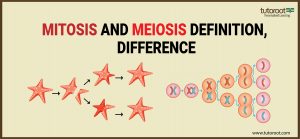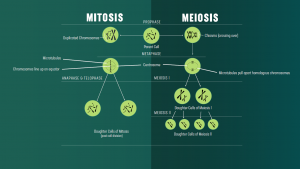Mitosis And Meiosis – Definition, Difference, Diagram
If you want to understand and learn many topics in biology easily, then it is necessary for you to understand the concepts, Mitosis and Meiosis in detail, along with the different stages involved in these two processes and cell division, etc. However, learning these concepts on your own might be a bit difficult. Therefore, to help you out, we put together a detailed guide about Mitosis and Meiosis in the article below.

What is Mitosis?
Mitosis is described as the process in which two daughter cells are formed, that have the same number and types of chromosomes, which are similar to that of parent cells. Moreover, this process is essentially controlled by certain genes, if not, there is a high chance of health problems in the individual such as cancer.
What is Meiosis?
Unlike the Mitosis process, Meiosis involves the formation of four daughter cells, which generally contain half the number of chromosomes, and the type of chromosomes, compared to that of the parent cell. Besides, this process makes sure that the number of chromosomes in each generation of the cell or the organism remains constant.
Mitosis and Meiosis Diagrams

The above diagrams help you understand the cell division mitosis and meiosis, how the cells are divided, as well as the different types of structures formed under these two processes.
Stages of Mitosis and Meiosis
Mitosis
This process involves four different stages, where certain functions will take place, which we will explain briefly here in the below section.
- This stage includes the replication of each chromosome, that is generally identical to each other, which is why they are referred to as sister chromatids.
- The second step is prophase, each of the duplicated chromosomes will now condense and thicken.
- In the Metaphase stage, all the duplicated chromosomes, assemble at the equator of the metaphase plate.
- And in the last stage, Anaphase, now the spindle fibers formed at the third stage, now contract. And all chromatids formed by this process, pull apart and are found on each pole.
Meiosis
Similar to the Mitosis process, the Meiosis process also involves four stages.
- Instead of the chromosomes, in this stage, the DNA is duplicated or replicated.
- In Prophase 1, Tetrad structure is formed, as the non-sister chromatids exchange their chromosomes at a specific point called Chiasmata.
- And in the next stage, the exchanged chromosomes are adjusted and they are arranged in the form of bivalent pairs.
- Then in the last stage, the homologous chromosomes drift towards the reverse poles.
Difference Between Mitosis and Meiosis
Now in this section, we will provide a comprehensive description of the difference’s mitosis and meiosis table below.
| Parameters | Mitosis | Meiosis |
| Definition | It involves the cell division in which two daughter cells are formed, that have the same type and number of chromosomes is the same as that of the parent cell. | This cell division results in the formation of four cells, that consist of half the chromosomes type and number of parent cells. |
| Type of Reproduction | Asexual | Sexual |
| Number of Chromosomes | Same as Parent Cell. | Half of the chromosomes exist in the parent cell. |
| Function | It is essential for growth, repair and reproduction of cells. | It is important for ensuring genetic diversity because of sexual reproduction. |
| Results | It creates different types of cells, except sex cells. | While this process results in the formation of sex cells. |
| Appearance | It is observed in somatic cells. | While it appears only in germ cells. |
| Types of Mother Cells | These cells can be either haploid or diploid. | These cells can only be diploid. |
Conclusion
Biology is generally one of the hardest subjects because of the inclusion of large syllabuses, involving multiple complex topics. And in order to get a better score in this subject, it is better to join an online coaching class. Currently, the Tutoroot platform is offering cost-effective online interactive classes for students with various benefits. If you want to learn more about the program and its benefits, visit the official website.
Frequently Asked Questions
What is the Purpose of Mitosis?
The process of mitosis ensures the genome is separated, and the two daughter cells formed have an identical number and the same type of chromosomes as their parent cell.
What is the end result of meiosis?
The meiosis process results in the formation of four haploid daughter cells, that consist of half the number and type of chromosomes as their parent cell.
What Happens in Telophase?
The Telophase stage involves three crucial steps in the mitosis process as decondensed of chromosomes, breakdown of spindles, and reformation of nucleoli as well as nuclear membranes.
